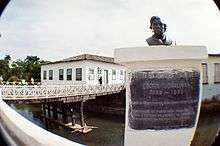Cora Coralina
| Cora Coralina | |
|---|---|
 Casa Velha da Ponte, the house where Cora lived and died. | |
| Born |
August 20, 1889 Goiás Velho, Empire of Brazil |
| Died |
April 10, 1985 (aged 95) Goiás Velho, Brazil |
| Occupation | Poet, prose writer. |
| Nationality |
|
Cora Coralina (Ana Lins dos Guimarães Peixoto) (August 20, 1889 – April 10, 1985) was a Brazilian writer and poet.
Biography
She is well-known for her writing on women's issues, life in the state of Goiás, the poverty of Northeastern Brazilians, and the mythology of Afro-Brazilian rituals.
Her poetry integrates most of the diverse cultures of Brazil. Her contemporaries include Argentine writer Alfonsina Storni, Uruguayan writer Juana de Ibarbourou and Chilean poet Gabriela Mistral. Almost all of her books have had more than ten editions.
She was born on August 20, 1889, and died in the city of Goiânia on April 10, 1985. She began to write poems when she was 14–15 years old, and attended the Clube Literário Goiano of Dona Virgínia da Luz Vieira. After her marriage to her husband, she went to live in São Paulo, where she had six children.
Her most well-known publications are Poemas dos becos de Goías e estorias mais and Estorias da Casa Velha da Ponte. She only published her first book (Poemas dos Becos de Goiás e Estórias Mais)[1] after her husband died, when she was 75 years old.[2] After her husband's death, she also dedicated her time to agricultural activities on a small estate in the interior of the state.
Cora worked all of her life in her little cake-store and produced more books, becoming one of the most important Brazilian writers of her time. In 1984, the Brazilian Union of Writers named her the "literary personality of the year." In this moment, Carlos Drummond de Andrade, a distinguished poet in Brazil and one of the most well-known in Latin America, said: "I admire Cora Coralina and her mastery of living in a state of grace with her poetry. Her verse is like running waters, her lyricism has the power and delicacy of the natural world."
Cora Coralina's house, where she lived from 1889 to 1985, can be visited in the city of Goiás. It is located at one end of the bridge over the Vermelho River. It is one of the earliest remaining buildings of Goiás, and a typical 18th century house; it inspired some of the most beautiful of her poems. There is a small museum in the house to honour her.
Kora corallina Simone, 2012, a species of Brazilian land snail is named in honour of her.[3]
Books
- Estórias da Casa Velha da Ponte
- Poemas dos Becos de Goiás e Estórias Mais, poetry, 1965
- Meninos Verdes, children's literature
- Meu livro de cordel
- O Tesouro da Casa Velha
- Vintém de Cobre
- A Moeda de Ouro que o Pato Engoliu, children's literature
Bibliography
- Clóvis Carvalho Britto, Rita Elisa Seda, Cora Coralina – Raízes de Aninha, Editora Idéias & Letras, 2011;
- Darcy França Denófrio, Cora Coralina – Coleção Melhores Poemas – Global Editora, 2004;
- Darcy França Denófrio, Goiandira Ortiz de Camargo, Cora Coralina: Celebração da Volta, Cânone Editorial, 2006;
- Vicência Bretas Tahan, Cora Coragem, Cora Poesia, Global Editora, 1989;
- Vicência Bretas Tahan, Villa Boa de Goyaz, Global Editora, 2001.
References
- ↑ Um teto todo seu : o itinerario poético-intelectual de Cora Coralina
- ↑ « A reescrita, na morte, da experiência de vida », revista Kairós, São Paulo, Caderno Temático 6, 2009.
- ↑ Simone L. R. L. (2012). "Taxonomical study on a sample of pulmonates from Santa Maria da Vitória, Bahia, Brazil, with description of a new genus and four new species (Mollusca: Orthalicidae and Megalobulimidae)". Papéis Avulsos de Zoologia 52(36): 431–439. doi:10.1590/S0031-10492012021600001, HTML.
External links
- (Portuguese) The house and museum of Cora Coralina
- (Portuguese) Cora Coralina and Modernism
- (Portuguese) Cora Coralina's House